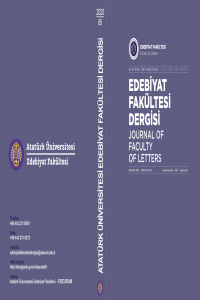THE TRANSITION FROM THE NEOCLASSICAL ‘BEAUTIFUL’ TO THE ROMANTIC ‘SUBLIME’: LONGINUS, BURKE AND KANT
Abstract
Longinus’s On the Sublime brought the concept of the sublime to the
centre of the Neoclassical and the Romantic aesthetics from the 17th century
onwards. His conception of the sublime inspired Edmund Burke’s A
Philosophical Enquiry into the Origin of Our Ideas of the Sublime and the
Beautiful (1756/57) and Immanuel Kant’s Critique of Judgement (1790) in the
18th century. Burke and Kant both differentiated the sublime from the beautiful
as an aesthetic category. Longinus’s non-differentiation between these
categories is the motivation behind both the Neoclassical and the Romantic
claim on his conception of the sublime. Relating the Longinian sublime to
Burke and Kant’s dualistic approach to the beautiful and the sublime, this study
argues that Burke’s reconsideration of the Longinian sublime in its empirical
relation to the object and Kant’s reformulation of it as a transcendental quality
of the mind have all progressively empowered the sublime’s dominion over the
beautiful, symbolising the Romantic takeover against the Neoclassical.
References
- Abrams, M.H. (1971). The Mirror and the Lamp: Romantic Theory and the Critical Tradition. London: Oxford University Press.
- Abrams, M.H. (1999). A Glossary of Literary Terms. 7th ed. New York: Harcourt Brace College Publishers.
- Aristotle. (1965). “On the Art of Poetry”. Classical Literary Criticism. T.S. Dorsch (Trans.). Middlesex: Penguin Books.
- Balfour, Ian. (2002). The Rhetoric of Romantic Prophecy. California: Stanford UP.
- Burke, Edmund. (1823). A Philosophical Enquiry into the Origin of our ideas of the Sublimeand Beautiful [1756/57], with an Introductory Discourse Concerning Taste, and Several Other Additions. London: Thomas M’Lean, Haymarket.
- Burke, Edmund. (2004). “A Philosophical Enquiry into the Sublime and Beautiful and Other Pre- Revolutionary Writings.” Critical Theory Since Plato.
- Hazard Adams and Leroy Searle (Ed.). Wadsworth Publishing.
- Burnham, Douglas. (2000). An Introduction to Kant’s Critique of Judgement. Edinburgh: Edinburgh UP.
THE TRANSITION FROM THE NEOCLASSICAL ‘BEAUTIFUL’ TO THE ROMANTIC ‘SUBLIME’: LONGINUS, BURKE AND KANT
Abstract
Longinus’s On the Sublime brought the concept of the sublime to the
centre of the Neoclassical and the Romantic aesthetics from the 17th century
onwards. His conception of the sublime inspired Edmund Burke’s A
Philosophical Enquiry into the Origin of Our Ideas of the Sublime and the
Beautiful (1756/57) and Immanuel Kant’s Critique of Judgement (1790) in the
18th century. Burke and Kant both differentiated the sublime from the beautiful
as an aesthetic category. Longinus’s non-differentiation between these
categories is the motivation behind both the Neoclassical and the Romantic
claim on his conception of the sublime. Relating the Longinian sublime to
Burke and Kant’s dualistic approach to the beautiful and the sublime, this study
argues that Burke’s reconsideration of the Longinian sublime in its empirical
relation to the object and Kant’s reformulation of it as a transcendental quality
of the mind have all progressively empowered the sublime’s dominion over the
beautiful, symbolising the Romantic takeover against the Neoclassical.
References
- Abrams, M.H. (1971). The Mirror and the Lamp: Romantic Theory and the Critical Tradition. London: Oxford University Press.
- Abrams, M.H. (1999). A Glossary of Literary Terms. 7th ed. New York: Harcourt Brace College Publishers.
- Aristotle. (1965). “On the Art of Poetry”. Classical Literary Criticism. T.S. Dorsch (Trans.). Middlesex: Penguin Books.
- Balfour, Ian. (2002). The Rhetoric of Romantic Prophecy. California: Stanford UP.
- Burke, Edmund. (1823). A Philosophical Enquiry into the Origin of our ideas of the Sublimeand Beautiful [1756/57], with an Introductory Discourse Concerning Taste, and Several Other Additions. London: Thomas M’Lean, Haymarket.
- Burke, Edmund. (2004). “A Philosophical Enquiry into the Sublime and Beautiful and Other Pre- Revolutionary Writings.” Critical Theory Since Plato.
- Hazard Adams and Leroy Searle (Ed.). Wadsworth Publishing.
- Burnham, Douglas. (2000). An Introduction to Kant’s Critique of Judgement. Edinburgh: Edinburgh UP.
Details
| Primary Language | English |
|---|---|
| Subjects | Creative Arts and Writing |
| Journal Section | Articles |
| Authors | |
| Publication Date | December 18, 2020 |
| Submission Date | August 11, 2020 |
| Published in Issue | Year 2020 Issue: 65 |


